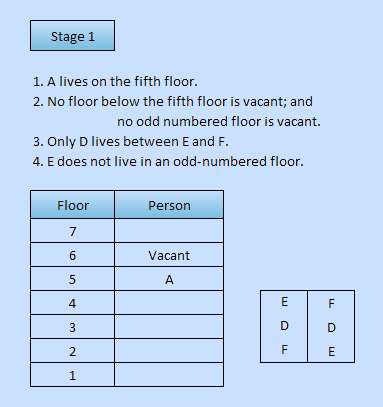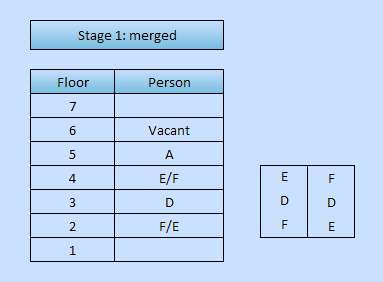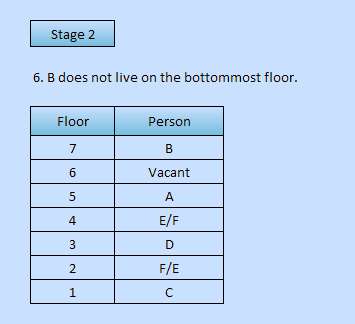
Need to solve the basic complexity involved in floor based puzzles
Using suitable logic table representation, solution to the floor based puzzle for Bank PO explains in clear steps how to solve a basic floor based puzzle.
Link of solution to reasoning puzzles for bank exams are at the end.
Basic floor based puzzle for Bank PO 3: Reasoning puzzles for Bank exams
Problem description
In a seven-storied building, having floors numbered 1 to 7, A, B, C, D, E, and F each live on a different floor. The ground floor is numbered floor number 1, the floor above it floor number 2 and so on. One of the floors in the building is vacant.
Conditional statements
- A lives on the fifth floor.
- No floor below the fifth floor is vacant; and no odd numbered floor is vacant.
- Only D lives between E and F.
- E does not live in an odd-numbered floor.
- E does not live on a floor immediately above or immediately below C's floor.
- B does not live on the bottom-most floor.
Questions
Question 1. Who lives on the topmost floor?
- C
- D
- B
- F
- None of these
Question 2. On which of the following floors does D live?
- Floor 1
- Floor 3
- Floor 5
- Floor 4
- None of these
Question 3. Which of the following floors is vacant?
- Floor 7
- Floor 4
- Floor 2
- Floor 6
- None of these
Question 4. Who lives just above A?
- B
- C
- E
- F
- None of these
Question 5. Who lives two floors above C?
- F
- E
- B
- D
- None of these
Solution to the basic floor based Puzzle for Bank PO 3: Reasoning puzzles for bank exams
Logic table representation
Following is the logic table that we will use for solving the problem.

First column of the two column logic table represents floor numbers and second column, the person living in a particular floor. As usual, the floors are numbered from 1 to 7, and from bottom to top. 1 is the bottom-most floor and 7 is the top floor.
There are seven floors and six persons, the vacant floor accounting for the shortfall in persons.
When we process the statements one by one, the conditions determine which person can occupy which floor. At the end of processing, no floor will have any uncertainty with respect to its occupancy. Each person will be placed on a distinct floor.
No cell will remain empty (the cell for the vacant floor will also be marked as vacant) after we complete analyzing all the conditional statements and we call this form of logic table as Compact logic analysis table.
You may skip now the following brief concepts and methods on reasoning puzzle problem solving, and come back to it after going through the solution to get a better understanding.
Brief concepts and methods on reasoning puzzle problem solving
It is not necessary that the conditional statements are to be processed starting from beginning to end. Usually that never happens. First step of any reasoning puzzle problem solving is to go through all the conditions and the description of the problem once. This is Initial problem analysis.
For large and complex reasoning puzzles, this step is essential to understand the complexity of the puzzle, identify the promising statements, identify the primary barrier, if any and so on.
Whatever be the problem though, at the start, those statements are taken up for processing first that fill up up maximum number of cells with certainty. This we call, direct assignment first strategy.
After a few cells get their values, the next strategy applied is link search, by which those statements are identified for processing that refer to any of the values of the already filled up cells.
In case link search fails, the statements that refer to multiple variable values of same type with fixed positional relation are taken up to create what we call temporary bonded member structures.
If there are two, but not more than two such possible structures involving two (or more) values of same variable, each of which we can place in specified positions without knowing which possible combination is the valid one, we create the two combinations as possible configurations. These are also temporary bonded structures but position of the values in each combination is known.
When positions of temporary bonded structure members are not known these are called floating bonded member structures.
Temporary bonded member structures are important because further conditions refer to variable values in the structures and make them more certain.
Let us now get down to the main task of processing the conditional statements with the sole aim of filling up the empty cells as quickly as possible without any confusion and with complete certainty.
Solution to basic floor based puzzle for Bank PO 3 Stage 1: Strategy 1: Direct and certain assignment first
In any assignment puzzle, Direct certain assignments in the beginning is a "highly preferred" priority. Without such a direct certain assignment of a secondary member to a position, we won't be able to place any member onto the logic table in the beginning, and further steps will be difficult to carry out.
We qualify this strategy with the additional property of a statement first to be executed as one with direct and certain assignments of maximum amount or maximum number of cells filled up with certainty.
We select such a statement and process it first to fill up maximum number of empty cells at one go. The advantage is, the more we fill up the empty cells easier does it become to fill up the rest, as uncertainty reduces.
Following this strategy, we select first Statement 1. "A lives on the fifth floor". By this statement A is placed on floor 5 with certainty. Continuing our lookout for more certain assignments next we select Statement 2. "No floor below the fifth floor is vacant; and no odd numbered floor is vacant".
This statement assigns "Vacant" status to floor 6. To reach this conclusion we needed to carry out elementary logic analysis which is the foundation of reasoning puzzle problem solving. The logic analysis is as below,
As no floor below fifth floor is vacant and no odd-numbered floor is vacant, out of possible floors 5, 6 and 7, floor 7 cannot be vacant. Again, floor 5 is already occupied by A. So floor 6 must be the vacant floor.
Finding no more direct assignment we search for a statement that relates multiple persons and so we select Statement 3. "Only D lives between E and F".
Essentially it says, D lives exactly between E and F and thus a temporary floating bonded member structure is created with two configurations, F-D-E and E-D-F. We don't know floor number of any of these three persons and so these two structures keep floating.
Adopting link search, we select next Statement 4. "E does not live in an odd-numbered floor". It refers to E, one of the values in the two bonded member structures we have just created. here again we need to carry out elementary logic analysis,
By Statement 4, E cannot be in any odd numbered floor; so none of the two configurations F-D-E or E-D-F can occupy cells 1, 2, 3 combination. If it were so, E had to occupy either cell 1 or cell 3 both of which are odd. Thus by statement 4, floors of both the structures have been assigned to 2-3-4.
D being the middle member, it is placed in the floor 3 with certainty. Floors 2 and 4 can have either E or F at this point of analysis.
This we call a two-degree uncertainty or cycle and record it as, E/F in cell 2 and F/E in cell 4. Effectively these two cells are blocked by E and F.
The following is the logic table after execution of these four statements in Stage 1.

At this stage we are able to merge the temporary bonded member structures with the main logic table placing D at floor 3 and E/F and F/E at floors 2 and 4. The following is the status after merging.

Solution to basic floor based puzzle for Bank PO 3 Stage 2: Achieving certain placement by negation and elimination
Only two floors 1 and 7 are empty now with two persons B and C yet to be placed.
This is the time when instead of next statement 5, we select Statement 6. "B does not live on the bottom-most floor". This is because, the Statement 6 refers to B, one of the two remaining persons to be placed in floors, and achieves its certain placement in floor 7.
This statement is a negation statement and as strategy we don't process this type of statements in the beginning when the table was relatively empty. For example, if four floors were empty including the bottom-most floor, and we processed this statement, B could have occupied any of the remaining three floors. This high degree uncertainty we don't accept in a statement. But at this late stage, only two floors are empty and this single negation places B at floor 7 with certainty. This again is elementary logic analysis combined with strategic selection of suitable time to execute the statement.
By exclusion or elimination C is assigned to floor 1, as it is the only remaining floor to be assigned and C is the only remaining person to be assigned.
The only uncertainty left is which cells E and F will actually occupy. To ascertain this we process the last statement at Stage 3.
Let us show the status of the resulting logic table after this Stage 2 processing.

Solution to basic floor based puzzle for Bank PO 3 Stage 3: Certain placement by conflict, elementary logic analysis;
At this last stage we process last Statement 5. "E does not live on a floor immediately above or immediately below C's floor." This statement achieves certain placement of E at floor 4 and F at floor 2 by conflict between positions of E and C expressed in the statement. The simple elementary logic analysis in this case is,
By Statement 5, as E cannot live immediately above C, it cannot be placed in floor 2. So F is placed in floor 2 and E in floor 4.
The final solved logic table after Stage 3 is shown below.

Now we are ready to answer the questions.
Answers to the questions: Basic floor based puzzle for Bank PO 3
Question 1. Who lives on the topmost floor?
Answer 1. Option 3: B.
Question 2. On which of the following floors does D live?
Answer 2. Option 2: Floor 3.
Question 3. Which of the following floors is vacant?
Answer 3. Option 4: Floor 6.
Question 4. Who lives just above A?
Answer 4. Option 5: None of these.
Question 5. Who lives two floors above C?
Answer 5. Option 4: D.
Comment
Though this is a simple basic level floor stay reasoning puzzle, a few of the basic logic puzzle solving concepts, structures and methods needed to be used along with elementary logic analysis. Briefly, it is identifying useful patterns and using appropriate methods.
Other resources for learning how to discover useful patterns and solve logic analysis problems
Einstein's puzzle or Einstein's riddle
The puzzle popularly known as Einstein's puzzle or Einstein's riddle is a six object set assignment logic analysis problem. Going through the problem and its efficient solution using collapsed column logic analysis technique in the session Method based solution of Einstein's logic analysis puzzle whose fish should be a good learning experience.
Playing Sudoku
As a powerful method of enhancing useful pattern identification and logic analysis skill, play Sudoku in a controlled manner. But beware, this great learning game, popularly called Rubik's Cube of 21st Century, is addictive.
To learn how to play Sudoku, you may refer to our Sudoku pages starting from the very beginning and proceeding to hard level games.
Reading list on SBI PO and Other Bank PO level Reasoning puzzles
Tutorials
How to solve SBI PO level logic puzzles in a few simple steps 1
How to solve SBI PO level logic puzzles in a few simple steps 2
How to solve SBI PO level family relation problems in a few simple steps 3
How to solve SBI PO level floor stay Reasoning Puzzle in a few confident steps 4
How to solve high level circular seating reasoning puzzles for SBI PO in confident steps 5
How to solve high level hard two row seating reasoning puzzles for SBI PO in confident steps 6
How to solve high level circular seating arrangement reasoning puzzles for SBI PO quickly 7
How to solve high level nine position circular seating reasoning puzzles for SBI PO quickly 8
How to solve high level box positioning reasoning puzzle for SBI PO quickly 9
Solved reasoning puzzles SBI PO type
SBI PO type high level floor stay reasoning puzzle solved in a few confident steps 1
SBI PO type high level reasoning puzzle solved in a few confident steps 2
SBI PO type high level reasoning puzzle solved in a few confident steps 3
SBI PO type high level circular seating reasoning puzzle solved in confident steps 4
SBI PO type high level hard reasoning puzzle solved in confident steps 5
SBI PO type high level one to many valued group based reasoning puzzle solved in confident steps 6
SBI PO type high level hard two in one circular seating reasoning puzzle solved in confident steps 7
SBI PO type hard facing away circular seating reasoning puzzle solved in confident steps 8
SBI PO type high level four dimensional reasoning puzzle solved in confident steps 9
SBI PO type hard two row seating reasoning puzzle solved in confident steps 10
SBI PO type high level floor stay reasoning puzzle solved in confident steps 11
Solved reasoning puzzles Bank PO type
Bank PO type two row hybrid reasoning puzzle solved in confident steps 1
Bank PO type four variable basic assignment reasoning puzzle solved in a few steps 2
Bank PO type basic floor based reasoning puzzle solved in a few steps 3
Bank PO type high level floor stay reasoning puzzle solved in quick steps 4
